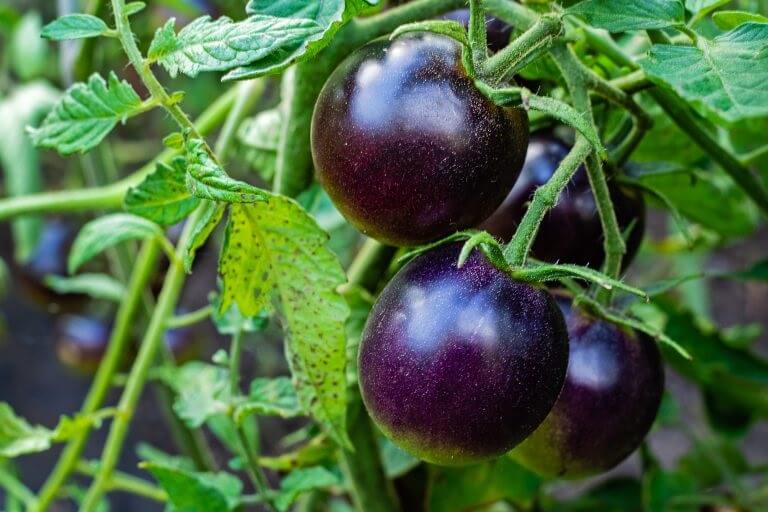By Sarah Biren | Guest Writer
You may find red, orange, or even green tomatoes at your local supermarket, but be prepared to potentially see purple ones next year. The USDA has approved a genetically modified purple tomato to be sold to the American public. In a September news release, the agency explained, “From a plant pest risk perspective, this plant may be safely grown and used in breeding.” [1] The scientists behind this project say the purple tomato has different health benefits and a longer shelf life compared to common red tomatoes. Plus, it would make a visually unique Pico de gallo or bruschetta.
The Science behind the Genetically Modified Purple Tomato
The team of scientists behind the genetically modified purple tomato included a project leader at the John Innes Centre in Norwich, England, and British biochemist Cathie Martin, who is a professor at the University of East Anglia. Martin had worked on flower pigment production for over two decades, which inspired her to turn to food. “I wanted to start projects where we could look and see whether there were health benefits for this particular group of pigments,” she said. [2]
She focused on pigments called anthocyanins, which give eggplants, blueberries, and blackberries their distinctly dark shades. So with the funding from a German consortium, she began to experiment with creating tomatoes with anthocyanins to see if that would “increase the antioxidant capacity” compared to regular tomatoes.
To achieve this effect, the scientists took genetic factors from snapdragons. This triggered the tomatoes to produce three times more anthocyanin, resulting in their distinct eggplant colour. In 2008, the team posted the first results of their research on Nature Biotechnology. [3] They fed the fruit to cancer-susceptible mice in a pilot study with fascinating results. These mice lived 30% longer than the control mice who ate regular tomatoes.
Martin explained there are many potential reasons why the purple tomatoes may provide different health benefits. There are “probably multiple mechanisms involved,” she said. “It’s not like a drug, where there’s a single target. It’s about them having antioxidant capacity. It also may influence the composition of the microbiome, so it’s better able to deal with digestion of other nutrients.”
A GMO Product for Shoppers, Not Manufacturers
In 2013, they released a new study showing that purple tomatoes had twice the shelf life of red tomatoes. [4] Eventually, Martin started a spinout company, Norfolk Plant Sciences, to start selling them commercially. They also are working on purple tomato juice, purple beefsteak tomatoes, purple cherry tomatoes, and purple sun-dried tomatoes. Additionally, there are seeds for people to grow their own purple tomatoes in their home gardens.
Historically, engineers worked on genetically modified foods approved by the FDA for the purpose of sustainable production; meanwhile, food modified for health benefits don’t have much precedence. For the first time, this product appeals to consumers instead of manufacturers, and provides them with additional nutrients and antioxidants. However, many people are concerned about GMOs, despite extensive research analysing their safety, and this could dramatically dampen potential sales.
But Nathan Pumplin, the CEO of Norfolk’s US-based commercial business, is optimistic about consumers’ responses. “We look at the problems facing our society as far as sustainability, climate change, health tied to diet and nutrition, and what’s clear from the response from our announcement is that it’s a really important topic to a lot of people,” Pumplin said. “I’m encouraged that a lot of people are starting to relook at biotechnology in light of the important challenges.”
Healthier and Tastier?
Now, the USDA has approved the genetically modified purple tomato; however, the company still needs approval from the FDA before fully commercializing. In the meantime, Norfolk plans to launch limited test markets in 2023 to find the tomato’s potential demographic. As far as taste goes, there’s no difference from red tomatoes. As Pumplin stated, “It tastes like a great tomato.”
Similarly, Fred Gould, co-director of the Genetic Engineering and Society Centre of North Carolina State University, states that ultimately consumers will decide the tomatoes’ success. Gould also points out that it’s unclear how much anthocyanin someone needs to consume to gain the health benefits. “There is some uncertainty in what they’re doing. Is this fruit actually healthier for you? Maybe it is, but it would be really interesting to see the data,” he said. “I think this is a good opportunity for people to start discussing what kind of evidence they would like to see to be convinced that these tomatoes are healthier.” [5]
Sources
- “APHIS Issues First Regulatory Status Review Response: Norfolk Plant Sciences’ Purple Tomato.” USDA. Rick Coker. September 6, 2022
- “A new, genetically modified purple tomato may hit the grocery market stands.” CNN. Zoe Sottile. September 17, 2022
- “Enrichment of tomato fruit with health-promoting anthocyanins by expression of select transcription factors.” Nature Biotechnology. Eugenio Butelli, Lucilla Titta, Marco Giorgio. November 26, 2008.
- “Anthocyanins Double the Shelf Life of Tomatoes by Delaying Overripening and Reducing Susceptibility to Gray Mold.” Current Biology. Yang Zhang, Eugenio Butelli, Rosalba De Stefano, Henk-jan Schoonbeek, Andreas Magusin, Chiara Pagliarani, Nikolaus Wellner, Lionel Hill, Diego Orzaez, Antonio Granell, Jonathan D.G. Jones, and Cathie Martin. June 17, 2013
- “A GMO Purple Tomato Is Coming to Grocery Aisles. Will the US Bite?” Wired. Emily Mullin. September 14, 2022

